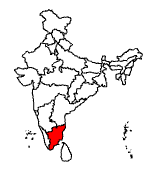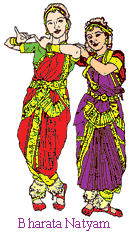
Dimdima
Online Children's Magazine from India

Dimdima
Online Children's Magazine from India
Tamil Nadu has a rich cultural life centred on its temple towns — Chidambaram, Kanchipuram, Thanjavur, and Madurai. The many temple festivals attract large numbers of devotees, especially during the car festivals, when chariots decorated with icons are taken in procession around the temples.
Area : 130,058 sq.km.
Population: 6,21,10,839
Language : Most people speak Tamil, the official state language and one of the oldest literary languages of India.
Capital : Chennai
Location :
Tamil Nadu, located in the south of the Indian subcontinent. To the north and west are the states of Andhra Pradesh, Karnataka and Kerala. To the east and south is the Bay of Bengal and the Indian Ocean. It is separated from Sri Lanka by the narrow Palk Strait.
Rivers :
The Kaveri is the state's most important river. Other rivers include the Ponnaiyar, the Palar, the Vaigai, and the Tambraparni, all flowing eastward. The rivers are Tamil Nadu's most important sources of water and power.
Mineral Resources : The state's rich mineral resources include limestone, bauxite, lignite, magnesite and iron ore. Cotton spinning and weaving are the major industries, followed by the production of automobiles, transformers, agricultural implements, fertilizers, cement, paper, chemicals, and electric motors. The state ranks second only to Kerala in the production of fish.
Climate :
The climate is typically tropical. The temperature in summer seldom exceeds 43º C and in winter, it never falls below 18º C. Rainfall occurs in winter, during the months of October to December.
Three dynasties ruled over Tamil Nadu in ancient times — the Cholas, the Pandyas and the Cheras.
Another dynasty, the Pallavas, rose to prominence in the 5th century A.D. and ruled over the Tamil Nadu region till the 9th century when Aditya Chola defeated the last Pallava king and took possession of his kingdom.
The Cholas remained the chief power in the region for four centuries. During the reign of Rajaraja Chola (985-1014), the Chola empire included the whole of South India, Kalinga, parts of Ceylon and Maldives.
Rajaraja’s son, Rajendra led his armies as far as eastern India. Another Chola expedition reached as far as Sumatra and the Malay Peninsula. The Chola presence in Southeast Asia lasted only about 50 years but in this short period Hinduism spread and took firm root and left its impress on local cultures for all time.
The Chola empire prevailed in South India till the end of the 13th century when the Pandyas pulled it down.
In 1639 the English were allowed to establish a settlement at the place which is now Chennai and Fort St. George was founded by the British East India Company. Slowly the whole of Tamil Nadu and most of South India came under British sway.
At the time of independence in 1947 Tamil Nadu was part of an administrative unit called the Madras Presidency. In 1956 Tamil-speaking areas of Madras Presidency were formed into a separate state called Madras.
In 1968 Madras state was renamed Tamil Nadu.
Tamil Nadu has a rich culture and its people cherish age-old traditions.
In a typical Tamilian home, you would probably awaken to the strains of Carnatic music, which was developed and fostered by the saint-poet Thyagaraja and two of his contemporaries. A music festival is held in January every year in Thiruvaiyaru, Thyagaraja's birthplace on the banks of the Kaveri.
January is rice harvest-time in Tamil Nadu and the best season to visit the state. The people celebrate the festival of Pongal. You can enjoy the sweet and savoury pongal, a rice dish, and wash it down with fragrant filter coffee.
You cannot miss the temples in Tamil Nadu.
The ancient and medieval rulers of the state built immense temples, rich in sculpture at Mahabalipuram, Tanjore, Madurai, Chidambaram and Rameswaram. These temples have towering gates known as gopurams.
There are temple-towns too. Madurai developed around the famous Meenakshi temple.
Tamil Nadu's famous dance form, Bharata Natyam developed in temples and moved on to the stage but it has lost none of its timeless appeal.
Chennai's Marina beach is well worth a visit. Thirteen kilometres in length, it is one of the longest beaches in the world. At the southern tip of Tamil Nadu is Kanyakumari, its shores washed by three seas — the Arabian Sea, the Indian Ocean and the Bay of Bengal.



Dimdima is the Sanskrit word for ‘drumbeat’. In olden days, victory in battle was heralded by the beat of drums or any important news to be conveyed to the people used to be accompanied with drumbeats.
Bharatiya Vidya Bhavan
K. M Munshi Marg,
Chowpatty, Mumbai - 400 007
email : editor@dimdima.com
Bharatiya Vidya Bhavan
505, Sane Guruji Marg,
Tardeo, Mumbai - 400 034
email : promo@dimdima.com
Dimdima.com, the Children's Website of Bharatiya Vidya Bhavan launched in 2000 and came out with a Printed version of Dimdima Magazine in 2004. At present the Printed Version have more than 35,000 subscribers from India and Abroad.